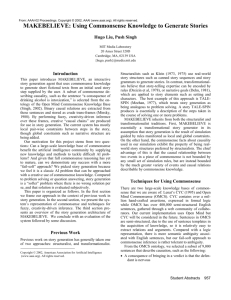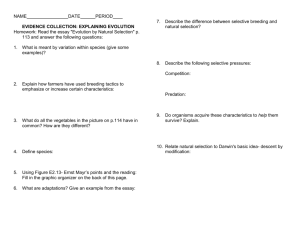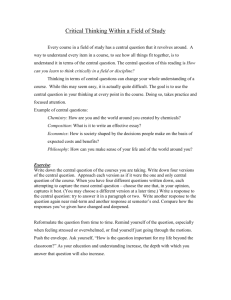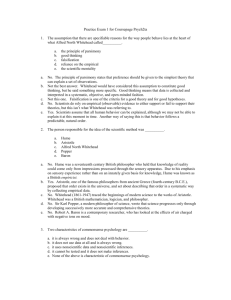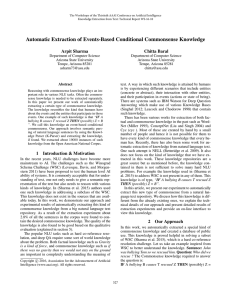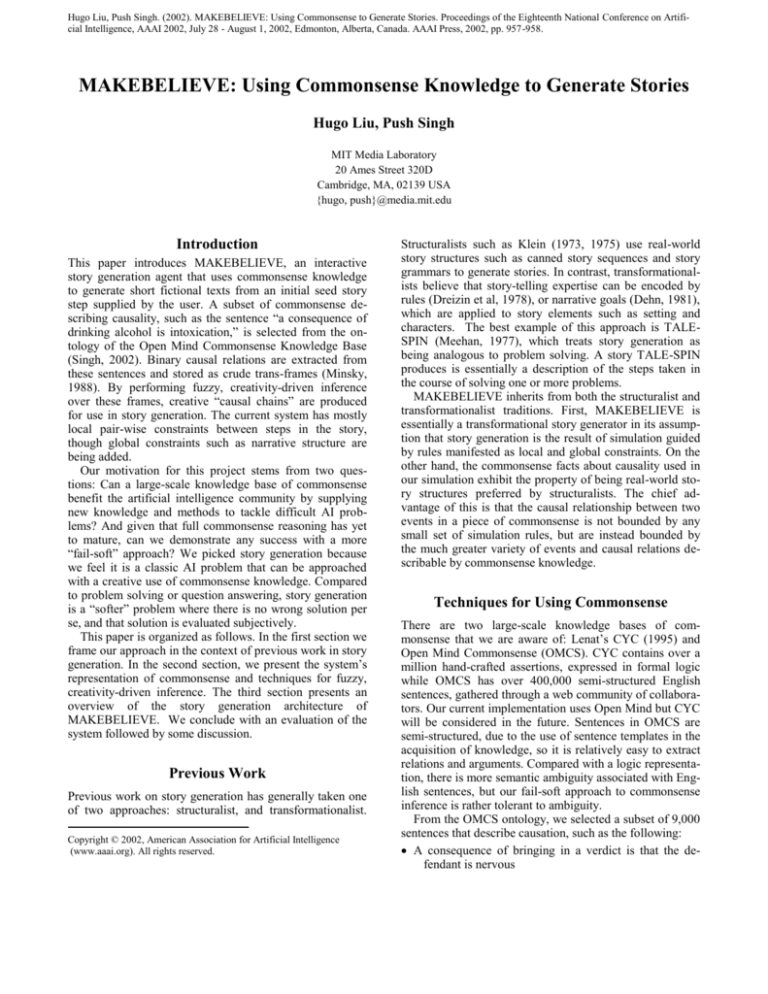
Hugo Liu, Push Singh. (2002). MAKEBELIEVE: Using Commonsense to Generate Stories. Proceedings of the Eighteenth National Conference on Artificial Intelligence, AAAI 2002, July 28 - August 1, 2002, Edmonton, Alberta, Canada. AAAI Press, 2002, pp. 957-958.
MAKEBELIEVE: Using Commonsense Knowledge to Generate Stories
Hugo Liu, Push Singh
MIT Media Laboratory
20 Ames Street 320D
Cambridge, MA, 02139 USA
{hugo, push}@media.mit.edu
Introduction
This paper introduces MAKEBELIEVE, an interactive
story generation agent that uses commonsense knowledge
to generate short fictional texts from an initial seed story
step supplied by the user. A subset of commonsense describing causality, such as the sentence “a consequence of
drinking alcohol is intoxication,” is selected from the ontology of the Open Mind Commonsense Knowledge Base
(Singh, 2002). Binary causal relations are extracted from
these sentences and stored as crude trans-frames (Minsky,
1988). By performing fuzzy, creativity-driven inference
over these frames, creative “causal chains” are produced
for use in story generation. The current system has mostly
local pair-wise constraints between steps in the story,
though global constraints such as narrative structure are
being added.
Our motivation for this project stems from two questions: Can a large-scale knowledge base of commonsense
benefit the artificial intelligence community by supplying
new knowledge and methods to tackle difficult AI problems? And given that full commonsense reasoning has yet
to mature, can we demonstrate any success with a more
“fail-soft” approach? We picked story generation because
we feel it is a classic AI problem that can be approached
with a creative use of commonsense knowledge. Compared
to problem solving or question answering, story generation
is a “softer” problem where there is no wrong solution per
se, and that solution is evaluated subjectively.
This paper is organized as follows. In the first section we
frame our approach in the context of previous work in story
generation. In the second section, we present the system’s
representation of commonsense and techniques for fuzzy,
creativity-driven inference. The third section presents an
overview of the story generation architecture of
MAKEBELIEVE. We conclude with an evaluation of the
system followed by some discussion.
Previous Work
Previous work on story generation has generally taken one
of two approaches: structuralist, and transformationalist.
Copyright © 2002, American Association for Artificial Intelligence
(www.aaai.org). All rights reserved.
Structuralists such as Klein (1973, 1975) use real-world
story structures such as canned story sequences and story
grammars to generate stories. In contrast, transformationalists believe that story-telling expertise can be encoded by
rules (Dreizin et al, 1978), or narrative goals (Dehn, 1981),
which are applied to story elements such as setting and
characters. The best example of this approach is TALESPIN (Meehan, 1977), which treats story generation as
being analogous to problem solving. A story TALE-SPIN
produces is essentially a description of the steps taken in
the course of solving one or more problems.
MAKEBELIEVE inherits from both the structuralist and
transformationalist traditions. First, MAKEBELIEVE is
essentially a transformational story generator in its assumption that story generation is the result of simulation guided
by rules manifested as local and global constraints. On the
other hand, the commonsense facts about causality used in
our simulation exhibit the property of being real-world story structures preferred by structuralists. The chief advantage of this is that the causal relationship between two
events in a piece of commonsense is not bounded by any
small set of simulation rules, but are instead bounded by
the much greater variety of events and causal relations describable by commonsense knowledge.
Techniques for Using Commonsense
There are two large-scale knowledge bases of commonsense that we are aware of: Lenat’s CYC (1995) and
Open Mind Commonsense (OMCS). CYC contains over a
million hand-crafted assertions, expressed in formal logic
while OMCS has over 400,000 semi-structured English
sentences, gathered through a web community of collaborators. Our current implementation uses Open Mind but CYC
will be considered in the future. Sentences in OMCS are
semi-structured, due to the use of sentence templates in the
acquisition of knowledge, so it is relatively easy to extract
relations and arguments. Compared with a logic representation, there is more semantic ambiguity associated with English sentences, but our fail-soft approach to commonsense
inference is rather tolerant to ambiguity.
From the OMCS ontology, we selected a subset of 9,000
sentences that describe causation, such as the following:
A consequence of bringing in a verdict is that the defendant is nervous
Something that might happen when you act in a play is
you forget your lines
A consequence of eating in a fast food restaurant may be
constipation
Before inference can be performed, we normalize the
English sentences into a consistent form, for which we
chose crude trans-frames, each with a before (cause) and
after (effect) event, further decomposed into verb-object
form with the help of a constituent structure parser. An
example of sentence and its corresponding frame follows:
“The effect of keeping things orderly and tidy is living
a better life.” {VERB: “keep” OBJS: “thing”
MANNER: (“orderly”, “tidy”) EFFECT: “living a better life”}
Fuzzy, creativity-driven inference. Once we have a repository of trans-frames, we perform inference by trying to
match the EFFECT of one frame to the CAUSE of some
other frame. The heuristic for fuzzy matching is a scoring
function that assigns points based on how closely the verb,
object, and manner of two events are related through lexical semantics. We used WordNet nymic relations (Fellbaum, 1998) to measure semantic proximity between nonverbs, and Levin’s verb classes (1993) in a similar way for
verbs. While not perfect, using lexical semantics to connect related, but not identical ideas overcomes some of the
brittleness associated with precise inference, and also has
the effect of lending creativity to the storyline.
MAKEBELIEVE Architecture
For brevity, our system’s architecture for story generation
can be summarized into the following processing steps:
1. The user enters the first sentence of the story.
2. The sentence is parsed into verb-object form and fuzzy
inference matches this initial event to the CAUSE slot of
some trans-frame in the repository.
3. The EFFECT slot of the same trans-frame is parsed and
inference continues, generating a whole chain of events.
4. After each step of inference, elements of the current
story step are modified by analogous or synonymous elements taken from lexical semantic resources. This is to
make sure that story steps deviate somewhat from the
sometimes too logical causality that is characteristic of
commonsense knowledge.
4. A global manager evaluates the chain of events to make
sure it is free of cycles and contradictions, and if necessary
it can backtrack to explore other storylines. Other global
constraints such as narrative structure will be added here.
5. In cases where the inference chain is completely stuck,
users may be asked to enter the next line in the story.
6. Frames of the inference chain and their corresponding
sentences are used to generate English sentences, with the
main character from the seed sentence being inserted. The
structure and syntax of sentences are kept very simple in
our current implementation.
An example. For brevity we present only one short story,
which is typical of stories generated by MAKEBELIEVE.
John became very lazy at work. John lost his job.
John decided to get drunk. He started to commit
crimes. John went to prison. He experienced bruises.
John cried. He looked at himself differently.
Conclusion
We have built MAKEBELIEVE, an interactive story generation agent that can generate short fictional texts of 5 to
20 lines when the user supplies the first line of the story.
Our fail-soft approach to story generation represents a hybrid approach inheriting from both the structuralist and
transformationalist traditions. It also incorporates a novel
knowledge source, commonsense, which unlike other story
knowledge bases, is not specifically purposed for story
telling. Using a subset of knowledge in Open Mind, which
describes causation, MAKEBELIEVE performs fuzzy and
creative inference to generate casual chains, which become
the basis for a storyline.
What sorts of limitations were encountered? The ambiguity inherent in any natural language representation makes
it difficult to resolve the bindings of agents to actions when
more than one agent is involved. For example, in this sentence from OMCS, “the effect of kicking someone is pain”,
we do not know enough to bind “pain” to the kicker or the
kicked. This ambiguity precludes our current system from
being able to tell multiple character stories.
A preliminary evaluation of MAKEBELIEVE was completed to serve as a baseline for future studies. 18 users
were asked to judge the creativity, quality, and coherence
of several five-line stories, generated as they interacted
with the agent. On average, users scored the stories 10 out
of a possible 15 points.
It was a pleasant surprise that despite being assembled
out of commonsense knowledge, stories turned out to be
much more interesting and dramatic from the user’s perspective than we might have imagined. Furthermore, even
though we did not add plot devices to the system such as
motifs, climax, tension, etc., many users in our evaluation
nonetheless felt that these devices were present in the generated stories. Where the generated story leaves off, the
imagination of the reader seems ready to pick up.
Selected References
Klein, S. et al. 1973. Automatic Novel Writing: A Status
Report. Wisconsin University
Meehan, J.R. 1977. TALE-SPIN, An interactive program
that writes stories in Proceedings of IJCAI-77, pp. 91-98
Singh, P. (2002). The public acquisition of commonsense
knowledge. In Proceedings of AAAI Spring Symposium:
Acquiring (and Using) Linguistic (and World) Knowledge
for Information Access. Palo Alto, CA, AAAI.

